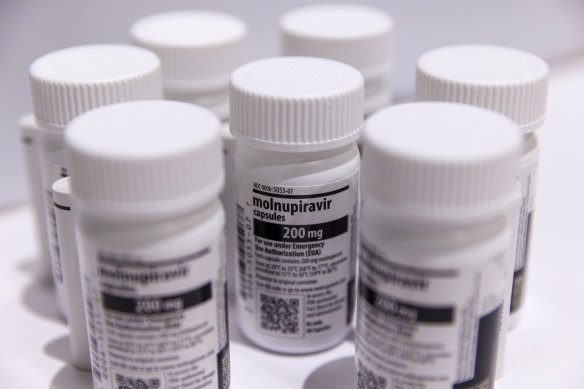
KEY POINTS
- An antiviral used to treat COVID-19 was found to do no better than a placebo in a British study.
- The drug, known as molnupiravir or Lagevrio, is prescribed to people at high risk of serious illness.
- The trial enrolled 25,783 people with COVID-19, half of whom got molnupiravir. After 28 days, 103 people given molnupiravir had died, compared with 96 in the second group.
A COVID-19 medication that was thought to strongly reduce the risk of the illness becoming life-threatening and was bought in bulk by the federal government works no better than a placebo, preliminary findings from a major new study suggest.
Molnupiravir, sold in Australia under the brand name Lagevrio, disrupts the coronavirus’ ability to copy itself and was the first COVID-19 antiviral to win government subsidy here.

The medication is intended for people at high risk of serious illness – those aged over 50 who have risk factors, and the immunocompromised – after they test positive to COVID-19 but before they are sick enough to need a hospital. Australia was one of the most aggressive movers in securing access to molnupiravir, buying 300,000 courses in late 2021, before it was approved by medical regulator the Therapeutic Goods Administration (TGA).
But some scientists have long been suspicious of strange results in the drug’s early trials. Data from the new trial has hardened their scepticism.
The University of Oxford’s PANORAMIC trial enrolled 25,783 people with COVID-19, half of whom got molnupiravir. After 28 days, 103 people given molnupiravir had died, compared with 96 in the second group.
“Clearly, it isn’t having a big impact,” said Professor Peter Wark, an expert on antivirals at the University of Newcastle. “I think we’d have to look very critically as to the cost-effectiveness of continuing in this sort of way.”
Governments keen to end COVID restrictions had leant on antivirals as a way out of the pandemic, Wark said. “A slower relaxation of restrictions probably would have had a bigger impact than relying heavily on these antivirals.”
Dr Kyle Sheldrick – a University of NSW researcher who co-authored a paper earlier this year on molnupiravir’s problems – is critical of the TGA’s approach.
“I did not think it should have been approved before PANORAMIC,” he said “I certainly don’t think it should be now.”
The Health Department did not answer questions on how much it had spent on the drug, but the US paid about $US700 ($1099) a dose at the same time.

Australia’s National COVID-19 Clinical Evidence Taskforce said it was reviewing the study and would probably soon update its recommendations, which endorse molnupiravir.
A spokesman for the drug’s sponsor Merck said PANORAMIC had focused on a low-risk group, and pointed to other studies showing the treatment was effective.
In April Merck predicted it would make $US5 billion to $US5.5 billion selling the drug this financial year.
In an effort to get more people using the drug, the Australian government widened eligibility in July and Merck launched an advertising campaign.
The federal government will purchase hundreds of thousands of a new pill designed to treat COVID-19.
Due to uncertainties about the clinical trial evidence, molnupiravir remains unapproved by the European Union; France cancelled its order in December.
Merck’s spokesman argued the patients in PANORAMIC were relatively healthy, whereas in Australia, the drug is reserved for people with major risk factors.
“Other recent real-world studies, including the Clalit study from Israel, have indicated that [molnupiravir] was associated with a significant reduction in hospitalisations and mortality due to COVID-19 in patients 65 years and above,” he said.
Initial uncertainties about molnupiravir stemmed from strange results in the original Merck trial that got the drug approved.
Merck’s trial recruited about 1500 patients and gave half the drug.
Early results from the first half of patients tested were so positive – a halving of the chance of death – that the trial was stopped early so everyone could get the apparently life-saving treatment.
But when data from the remaining half of patients in the trial was published a month later, it told a different story. The second group had done far worse than the first. In fact, the data suggested molnupiravir did not improve their outcomes.
Combined, the full trial suggested molnupiravir may not cut the risk of death.
“We think this is unprecedented. None of us had ever seen anything like this before,” said Sheldrick.
The strange results may have been caused by a new coronavirus variant emerging mid-trial, he said. Merck disputes that, and claims the early results were the key ones.
Wark said it was possible the drug was of less use in a highly vaccinated population faced with a milder variant such as Omicron.
Sheldrick said the PANORAMIC results suggested governments need to think differently about rushing to approve drugs with limited evidence – even in the middle of a pandemic.
A spokeswoman for the TGA said the drug remained provisionally approved for use.
“It is noted that while, in the PANORAMIC trial, hospitalisation and death was not reduced by molnupiravir for adults under 65 years, the time to first self-reported recovery was six days shorter.”
